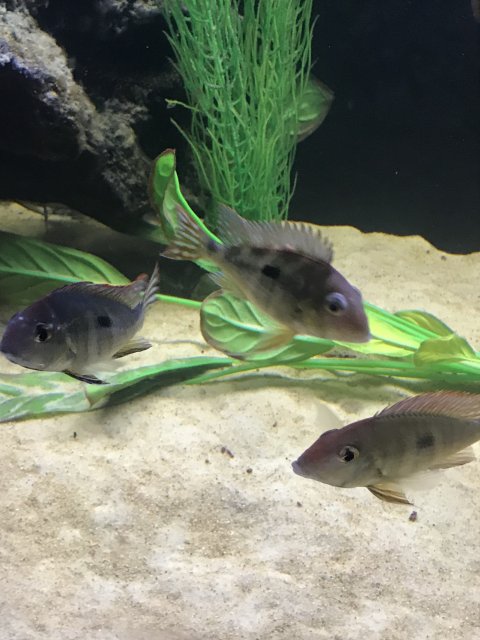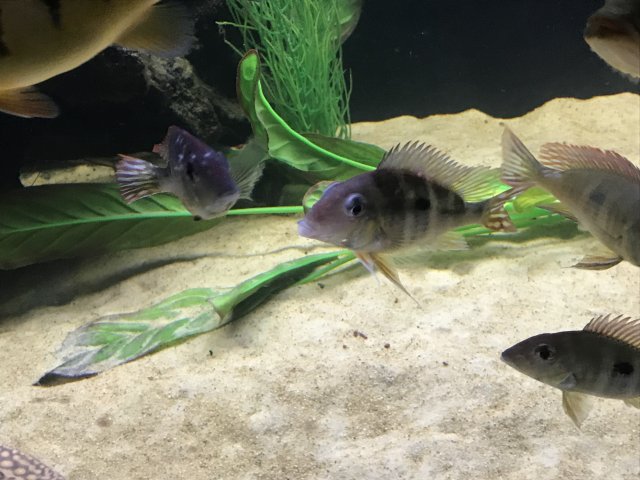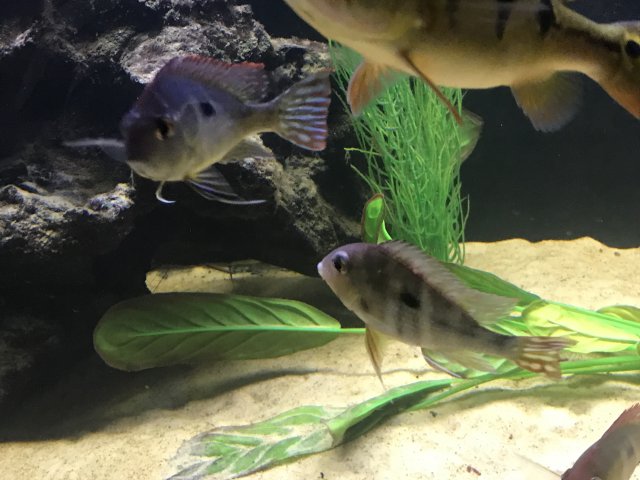You are using an out of date browser. It may not display this or other websites correctly.
You should upgrade or use an alternative browser.
You should upgrade or use an alternative browser.
Hard to get any better pictures, but the main symptoms appear to be:
- lots of small marks on the skin around the head
- one of the Geos affected appears to have slightly bulging eyes
- different colour to the other Geos, they almost seem to have a blue/grey tint?
The Kelberi are very placid so fairly confident they aren’t picking on them and nor is the ray. If anything the other Geos are a bit nippy with them and I often see hem bullying each other (group of 5).
- lots of small marks on the skin around the head
- one of the Geos affected appears to have slightly bulging eyes
- different colour to the other Geos, they almost seem to have a blue/grey tint?
The Kelberi are very placid so fairly confident they aren’t picking on them and nor is the ray. If anything the other Geos are a bit nippy with them and I often see hem bullying each other (group of 5).
Nitrate of 20-40 ppm may be too high for some Geo's, some species can be intolerant of such a high level.
Most of their natural water have nitrate under 5 ppm (if not 0), and the seasonal natural tannins, are also antibacterial.
If it were me, I'd increase my water change, and filter cleaning schedule to bring nitrate down to 10ppm or under.
And depending on how the breeder raised them, even 7.4 pH may be slightly high, depending on conductivity (mineral content), if the breeder used RO to bring conductivity down, and yours is high, it could be a problem.
You may wonder why only the Geo's are affected, and not the others.
P-bass seem to have a much higher tolerance for water with high mineral content, here in Panama they thrive in lake Gatun where pH often rises to 9 and the lake gets surges of sea water (although they don't get to the sizes found in the soft waters of the Amazon).
Most of their natural water have nitrate under 5 ppm (if not 0), and the seasonal natural tannins, are also antibacterial.
If it were me, I'd increase my water change, and filter cleaning schedule to bring nitrate down to 10ppm or under.
And depending on how the breeder raised them, even 7.4 pH may be slightly high, depending on conductivity (mineral content), if the breeder used RO to bring conductivity down, and yours is high, it could be a problem.
You may wonder why only the Geo's are affected, and not the others.
P-bass seem to have a much higher tolerance for water with high mineral content, here in Panama they thrive in lake Gatun where pH often rises to 9 and the lake gets surges of sea water (although they don't get to the sizes found in the soft waters of the Amazon).
In many cases with elevated water parameters like nitrate, in combination with higher conductivity than is normal for a certain species, ill health is not immediately apparent, or acute.
Those off kilter parameters cause chronic problems, like suscepability to certain bacteria (HLLE) or other even more subtle maladies, giving the impression of mystery disease or worse.
I know many people think I'm blowing this stuff out of my ***, and that I blather on and on about the toxicity of "less toxic" nitrate, but its effects are cumulative (especially when combined with other not so natural water, for a species) but it is because its effects are so subtle, why it is often overlooked.
Those off kilter parameters cause chronic problems, like suscepability to certain bacteria (HLLE) or other even more subtle maladies, giving the impression of mystery disease or worse.
I know many people think I'm blowing this stuff out of my ***, and that I blather on and on about the toxicity of "less toxic" nitrate, but its effects are cumulative (especially when combined with other not so natural water, for a species) but it is because its effects are so subtle, why it is often overlooked.
There's no way those nitrate levels are toxic. It could be anything but nitrates.
I would suspect a bacterial infection and would remove them to a hospital tank.
Finding a vet that sees fish would be best since hobbyists are rarely able to accurately diagnose and correctly treat fish.
I would suspect a bacterial infection and would remove them to a hospital tank.
Finding a vet that sees fish would be best since hobbyists are rarely able to accurately diagnose and correctly treat fish.
In many cases with elevated water parameters like nitrate, in combination with higher conductivity than is normal for a certain species, ill health is not immediately apparent, or acute.
Those off kilter parameters cause chromic, slowly creeping problems, like suscepability to certain bacteria (HLLE) or other even more subtle maladies, giving the impression of mystery disease or worse.
I know many people think I'm blowing this stuff out of my ***, and that I blather on and on about the toxicity of "less toxic" nitrate, but its effects are cumulative (especially when combined with other not so natural water, for a species) but it is because its effects are so subtle, why it is often overlooked.
How are the effects cumulative?
Gills and integument are impermeable to nitrate so its only route of entry is incidental ingestion. It's converted to nitrite in the digestive tract and results in methemoglobinemia.
This is an incredibly inefficient method of intoxication.
Nitrate toxicity at these levels is 100% myth.






